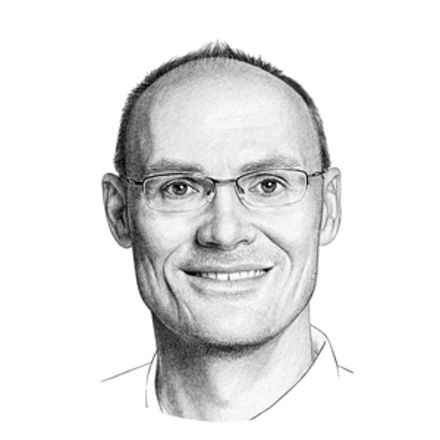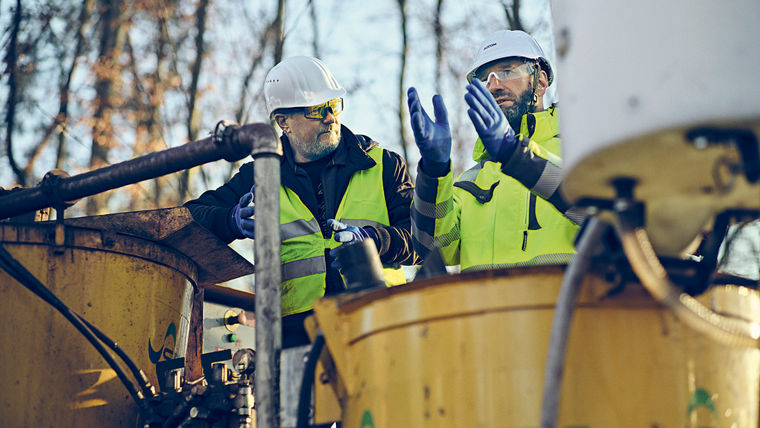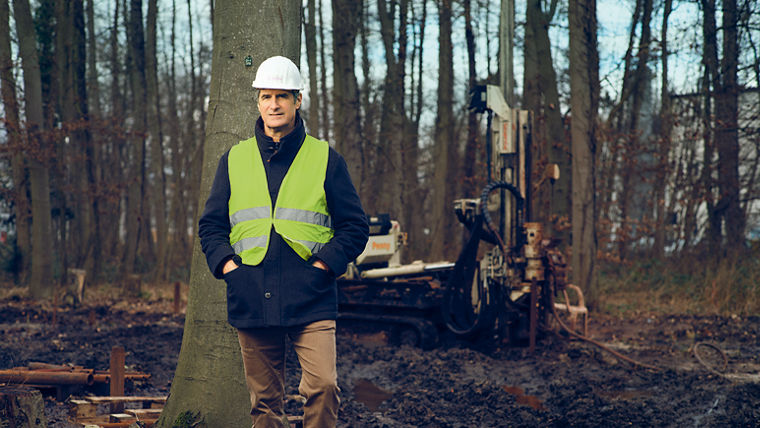Pioneer Park has an idyllic location, next to a forest on the outskirts of Hanau. A small river, the Kinzig, flows nearby. The residents of the new housing area will be able to go for walks here in the future, and children can play in the forest. Around 5,000 people will live on the site of the former US Army installation in a few years’ time. The US military moved to the site near Frankfurt am Main after the World War II and decommissioned it in 2008. The old barracks and workshop buildings have been demolished and a residential quarter is now being built here. The site still looks a little bare, but many terraced and detached houses as well as small two-story apartment blocks are already inhabited.
What is unusual about this new development area are the arm-thick metal pipes that protrude from the ground in many places. They reach several meters deep into the ground, down to the groundwater. Technicians regularly visit the site to take water samples, because for a long time the soil contained unwanted residues from the US Army: chlorinated hydrocarbons (CHCs). CHCs are fat-soluble and were used for decades in textile cleaning or to clean machines, including in the former Pioneer barracks.
However, the substances are harmful to health if people come into contact with them, for example if they water their vegetables with water from contaminated domestic wells.

The fact that people can now live and work in this place is thanks to a product from Evonik. An environmentally friendly substance called EHC Reagent causes chlorinated hydrocarbons to be converted into harmless substances in the soil.
This cost-effective and sustainable process could be employed in the future on many conversion sites that were previously used for industrial or military purposes, offering local authorities and the real estate sector an interesting solution.
ELEMENTS-Newsletter
Receive exciting insights into Evonik's research and its societal relevance—conveniently via email.
Dangerous cleaning agents
Soil contaminants are a huge problem worldwide. According to estimates by the European Environment Agency, there are around 250,000 known contaminated sites in Europe alone. In addition, there are around 1.8 million areas that are suspected of being contaminated.
Extensive preparatory work is required before new apartments or modern commercial areas can be built on these sites. In Germany and other European countries, contaminated material is usually dug up and sent to landfill (“dig and dump”). Alternatively, the contaminated groundwater is pumped out and treated. “These processes account for around 90 percent of the market,” says Mike Mueller, who is behind the invention of EHC Reagent.
Those responsible in Hanau also had to act before the former army site could be put to new use. Over the years, a dry cleaning facility had leaked particularly large quantities of CHCs into the soil. The military used cleaning agents containing these compounds to clean soldiers’ clothing. A few hundred meters away at the old workshops, where vehicle parts used to be degreased, CHCs also entered the soil; around three tons in total.

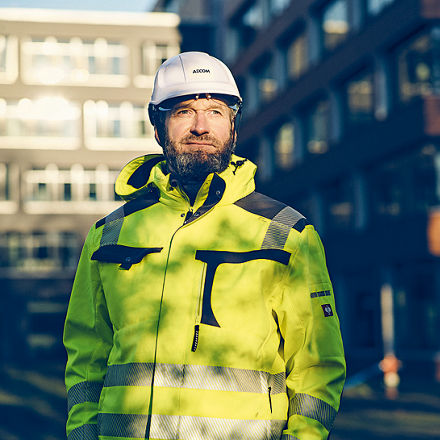
»We took samples to determine the size of the contaminated area«
PETER MARTUS technical director at the environmental consultancy firm Aecom
The project development company LEG Hessen-Hanau, which took over the site a few years ago, decided to comprehensively redevelop the 500,000 square meter area. It was supported by the engineering company Aecom from Frankfurt.
“The first step was to take soil and groundwater samples to determine the size of the contaminated area,” says Dr. Peter Martus, Technical Manager at Aecom. The investigation showed that the groundwater flows from east to west underneath the former cleaning building and the workshop area and even transfers the CHCs beyond the barracks site as an underground contaminant plume. At around 11,000 square meters, the contaminated area was larger than a soccer field and up to 15 meters thick.
In the case of smaller contaminated sites such as gas stations, the soil can usually be removed relatively easily or the contaminated groundwater cleaned. Both procedures were ruled out in this case. It would have been uneconomical to replace the soil at several depths and across the entire width. A pump-and-treat procedure would have taken many years. In addition, the strict remediation target would probably not have been achieved. Martus therefore suggested an alternative method, cleaning the soil in situ. In this process, substances that destroy or bind pollutants and thus render them harmless are injected into the soil.

LEG Hessen-Hanau agreed, and Martus contacted his colleague Gordon Bures from the remediation company Sensatec. Bures hails from Canada and is an expert in contaminants. “There and in the USA, EHC Reagent from Evonik has been used for some time to clean up contaminated CHC sites,” says Bures, “and it seemed to be the method of choice in Hanau too.”
Iron and plant fibers
EHC Reagent consists of two environmentally friendly and sustainable main ingredients: coarse iron powder, which is made from scrap metal, and plant fibers, which are a by-product of horse feed production. A thickening agent is also added. If EHC Reagent is mixed with water, a viscous mass is formed that can be easily pumped into the ground. The combination of carbon from the feed residues and elemental iron gives the product a special property: It attacks the toxic chlorinated hydrocarbon molecules in several ways and thus breaks them down thoroughly.
In view of the enormous size of the site, the partners in Hanau proceeded slowly. In a pilot phase, EHC Reagent was initially pumped into the ground in the particularly heavily contaminated area around the former dry cleaning facility. “We wanted to see the extent to which the CHCs were actually being broken down,” says Bures. After the injection of the EHC Reagent mass was completed, Aecom employees regularly took groundwater samples. After a few months, they could see that the CHC molecules had been freed from the chlorine atoms, i.e. dechlorinated, by the biological and chemical reactions in the soil. Later, the only decomposition products detectable in the groundwater were small carbon compounds, chloride, and water. “This is a great success,” says Bures. Injection wells were then drilled throughout the contaminated area. As the groundwater analyses show, the CHCs have now been broken down almost everywhere in the remediated areas.

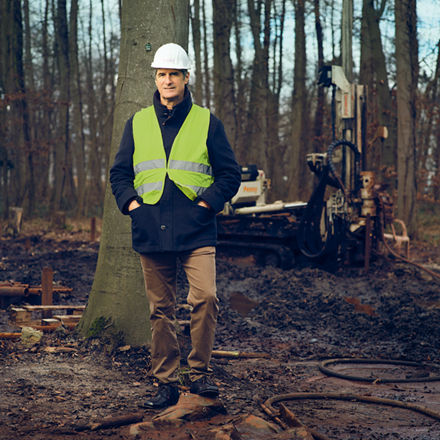
»EHC Reagent seemed to us to be the method of choice in Hanau«
GORDON BURES technical director at the remediation company Sensatec
Bures is one of the developers of the injection method, in which a drill pipe is slowly driven into the ground. The drilling process is paused approximately every 50 to 75 centimeters and EHC Reagent pumped into the ground via the drill pipe.
The pressure expands the pore space underground so that the mass is distributed in a radius of up to five meters around the borehole. A total of 200 tons of EHC Reagent were pumped into the ground at Pioneer Park. Little by little, it destroyed the CHC molecules so that the groundwater flowing through the area today no longer contains any pollutants. Because the EHC Reagent suspension is viscous, the groundwater cannot wash it away. It stays in place for several years.

Reaction in the soil

The CHCs are broken down in three different ways. Firstly with the help of soil bacteria and secondly via two different chemical reaction pathways with the help of iron. The carbon contained in the feed waste serves as food for the bacteria. They break down the food residues and release various fatty acids, including formic, butyric and lactic acid. These fatty acids in turn feed other bacteria that dechlorinate the CHCs. The chemical reaction with the iron takes place directly. In the first case, the iron reacts immediately with the chlorine compounds. In the second, it first dissolves in the groundwater and then breaks down the CHCs via a slightly different reaction path.
From a startup to part of Evonik
The American manager Mike Mueller has accompanied the development of EHC Reagent from the very beginning. He first established the product in the USA and Canada with his startup. The startup was then absorbed by the US company Peroxychem, which was taken over by Evonik in 2020. Since then, Mueller has been working for the specialty chemicals company, and is now introducing EHC Reagent to the European market as a promising substance for in-situ processes. “EHC Reagent’s strength is the combination of bacterial and chemical decomposition. This makes the process particularly efficient,” says Mueller.
Evonik’s solution meets even the most stringent requirements. As there is a drinking water extraction point in the immediate vicinity of Pioneer Park, the responsible authorities have set a maximum CHC value of 20 micrograms per liter of water, which corresponds to the standard for potable water. Normally, limit values of a few hundred micrograms are set as a remediation target for urban areas. The water samples that are regularly taken on the site show that the level is already below 20 micrograms in many areas. Measurements will also be taken regularly at a total of 140 locations in the years ahead.
Some investors and agency representatives still tend to remove the contaminated soil, reports Mueller. Some people are not comfortable with the idea of treating the pollutants underground. However, Mueller has since been able to convince the relevant agencies in several federal states that EHC Reagent is a sensible alternative. In the meantime, it has also been used in more than 200 projects throughout Europe.

A total of 200 tons of EHC Reagent have been used at Pioneer Park, making it the largest remediation project for the substance in Europe to date. “If the contaminated area had been excavated, hundreds of truck journeys would have been necessary to remove the soil,” says Mueller. Martus and his colleagues at Aecom have analyzed in detail how much more environmentally friendly the in-situ process is compared to excavation or groundwater purification. They took truck transportation, the power consumption of the pumps, and many other parameters into account. This showed that remediation using EHC Reagent at Pioneer Park produced 90 percent less carbon dioxide emissions than the excavating contaminated ground and 70 percent less than pumping out and treating the groundwater.

»The mixture of bacterial and chemical decomposition makes the process particularly efficient«
Mike Mueller EMEA Business Manager for Soil & Groundwater Remediation at Evonik’s Active Oxygens business line
The in-situ method is also more cost-effective. Soil remediation with excavation, removal, and dumping or treatment of the soil would have been at least three times as expensive as the in-situ treatment with EHC Reagent. For the construction industry and investors, military and industrial wastelands are attractive areas on which apartments can be built, says Mueller. “EHC Reagent enables land to be sustainably and, above all, quietly freed from contamination.”
Others also seem to see the Pioneer Park project as a complete success. In 2024, it was honored with Germany’s most important award in the remediation industry, the Brownfield Award. The project was awarded third place in the “Particularly sustainable” category.
Project on Evonik factory premises
Evonik is also currently dealing with a contaminated site in a second project in Hanau. It involves the in-situ remediation of an area on a factory site that is contaminated with arsenic compounds. In 1875, the Royal Prussian Gunpowder Factory was established there, which also processed arsenic during the First World War. Some of the arsenic at the site is geogenic—it comes from natural sources. Under parts of the facility, the arsenic was originally bound in solid iron compounds in bog iron ore deposits in the ground. However, the work in the gunpowder factory and other industrial activities during the long period of use chemically altered the soil in such a way that the arsenic was released from the bog iron ore. “Today we are faced with the task of securing this historic contaminated site so that the arsenic does not continue to pollute the groundwater,” says Pascal Endres, who is responsible for contaminated site management at Evonik’s Hanau facility.
Until now, the groundwater has been continuously pumped out to prevent it from carrying arsenic beyond the plant site. However, pumping consumes a lot of energy and the pumps require regular maintenance. “After considering various options and intensive concept coordination with the responsible authority and our environmental expert, we decided to use an in-situ measure. It’s a more sustainable cleanup method,” says Endres. Injection drilling is currently being carried out in Hanau, as was previously done at Pioneer Park. However, the products used in Hanau are Geoform ER and Metafix, two reagents that create suitable geochemical conditions in the subsurface to immobilize the arsenic.

Specifically, they create the extremely durable and inert mineral arsenopyrite, which also occurs in natural rock. “Hydrocarbons such as those at Pioneer Park can be chemically decomposed, but metals such as arsenic cannot,” explains Endres, “so it makes sense to chemically bind them permanently on site so that they no longer pollute the groundwater.”

